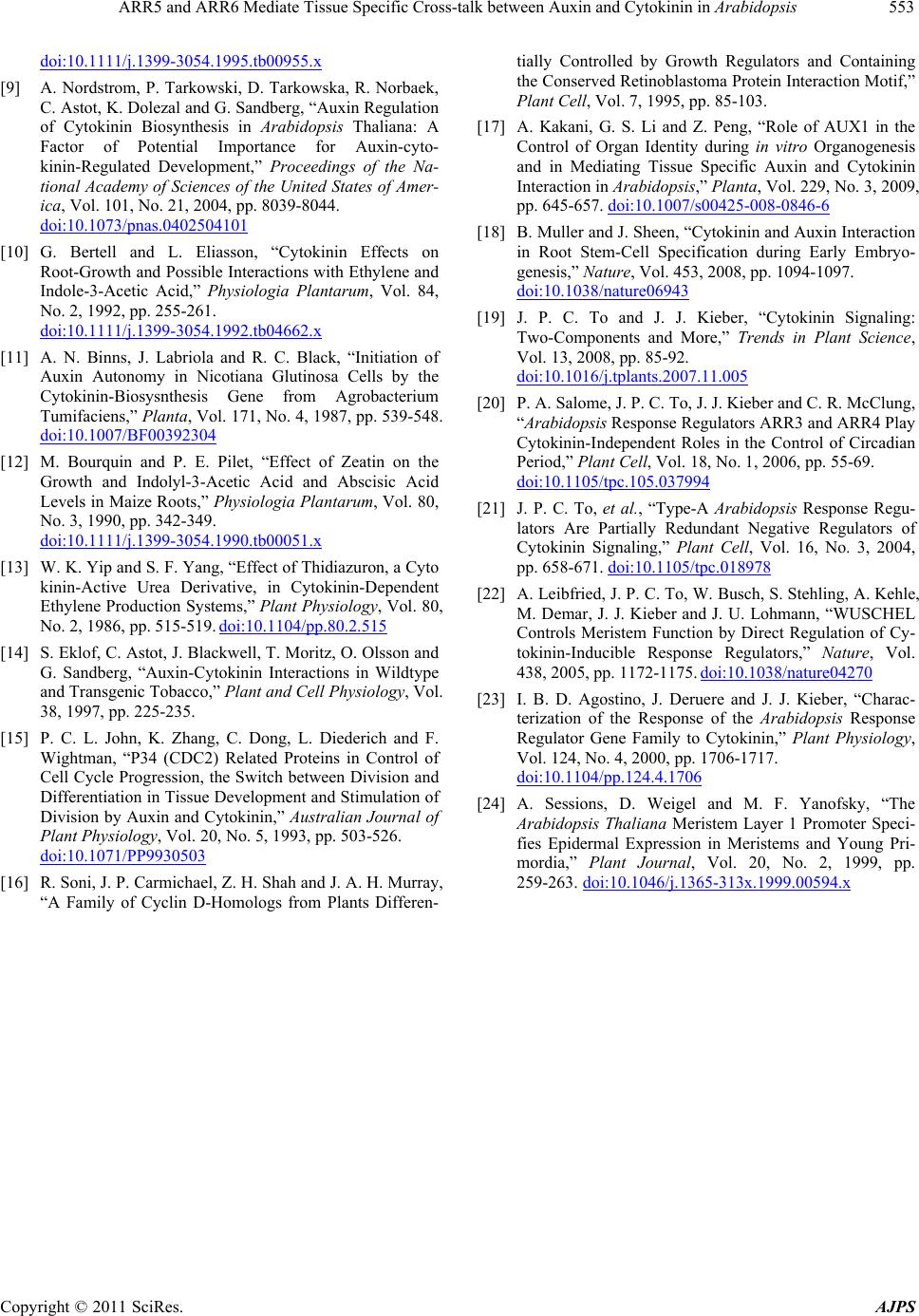
ARR5 and ARR6 Mediate Tissue Specific Cross-talk between Auxin and Cytokinin in Arabidopsis
Copyright © 2011 SciRes. AJPS
553
doi:10.1111/j.1399-3054.1995.tb00955.x
[9] A. Nordstrom, P. Tarkowski, D. Tarkowska, R. Norbaek,
C. Astot, K. Dolezal and G. Sandberg, “Auxin Regulation
of Cytokinin Biosynthesis in Arabidopsis Thaliana: A
Factor of Potential Importance for Auxin-cyto-
kinin-Regulated Development,” Proceedings of the Na-
tional Academy of Sciences of the United States of Amer-
ica, Vol. 101, No. 21, 2004, pp. 8039-8044.
doi:10.1073/pnas.0402504101
[10] G. Bertell and L. Eliasson, “Cytokinin Effects on
Root-Growth and Possible Interactions with Ethylene and
Indole-3-Acetic Acid,” Physiologia Plantarum, Vol. 84,
No. 2, 1992, pp. 255-261.
doi:10.1111/j.1399-3054.1992.tb04662.x
[11] A. N. Binns, J. Labriola and R. C. Black, “Initiation of
Auxin Autonomy in Nicotiana Glutinosa Cells by the
Cytokinin-Biosysnthesis Gene from Agrobacterium
Tumifaciens,” Planta, Vol. 171, No. 4, 1987, pp. 539-548.
doi:10.1007/BF00392304
[12] M. Bourquin and P. E. Pilet, “Effect of Zeatin on the
Growth and Indolyl-3-Acetic Acid and Abscisic Acid
Levels in Maize Roots,” Physiologia Plantarum, Vol. 80,
No. 3, 1990, pp. 342-349.
doi:10.1111/j.1399-3054.1990.tb00051.x
[13] W. K. Yip and S. F. Yang, “Effect of Thidiazuron, a Cyto
kinin-Active Urea Derivative, in Cytokinin-Dependent
Ethylene Production Systems,” Plant Physiology, Vol. 80,
No. 2, 1986, pp. 515-519. doi:10.1104/pp.80.2.515
[14] S. Eklof, C. Astot, J. Blackwell, T. Moritz, O. Olsson and
G. Sandberg, “Auxin-Cytokinin Interactions in Wildtype
and Transgenic Tobacco,” Plant and Cell Physiology, Vol.
38, 1997, pp. 225-235.
[15] P. C. L. John, K. Zhang, C. Dong, L. Diederich and F.
Wightman, “P34 (CDC2) Related Proteins in Control of
Cell Cycle Progression, the Switch between Division and
Differentiation in Tissue Development and Stimulation of
Division by Auxin and Cytokinin,” Australian Journal of
Plant Physiology, Vol. 20, No. 5, 1993, pp. 503-526.
doi:10.1071/PP9930503
[16] R. Soni, J. P. Carmichael, Z. H. Shah and J. A. H. Murray,
“A Family of Cyclin D-Homologs from Plants Differen-
tially Controlled by Growth Regulators and Containing
the Conserved Retinoblastoma Protein Interaction Motif,”
Plant Cell, Vol. 7, 1995, pp. 85-103.
[17] A. Kakani, G. S. Li and Z. Peng, “Role of AUX1 in the
Control of Organ Identity during in vitro Organogenesis
and in Mediating Tissue Specific Auxin and Cytokinin
Interaction in Arabidopsis,” Planta, Vol. 229, No. 3, 2009,
pp. 645-657. doi:10.1007/s00425-008-0846-6
[18] B. Muller and J. Sheen, “Cytokinin and Auxin Interaction
in Root Stem-Cell Specification during Early Embryo-
genesis,” Nature, Vol. 453, 2008, pp. 1094-1097.
doi:10.1038/nature06943
[19] J. P. C. To and J. J. Kieber, “Cytokinin Signaling:
Two-Components and More,” Trends in Plant Science,
Vol. 13, 2008, pp. 85-92.
doi:10.1016/j.tplants.2007.11.005
[20] P. A. Salome, J. P. C. To, J. J. Kieber and C. R. McClung,
“Arabidopsis Response Regulators ARR3 and ARR4 Play
Cytokinin-Independent Roles in the Control of Circadian
Period,” Plant Cell, Vol. 18, No. 1, 2006, pp. 55-69.
doi:10.1105/tpc.105.037994
[21] J. P. C. To, et al., “Type-A Arabidopsis Response Regu-
lators Are Partially Redundant Negative Regulators of
Cytokinin Signaling,” Plant Cell, Vol. 16, No. 3, 2004,
pp. 658-671. doi:10.1105/tpc.018978
[22] A. Leibfried, J. P. C. To, W. Busch, S. Stehling, A. Kehle,
M. Demar, J. J. Kieber and J. U. Lohmann, “WUSCHEL
Controls Meristem Function by Direct Regulation of Cy-
tokinin-Inducible Response Regulators,” Nature, Vol.
438, 2005, pp. 1172-1175. doi:10.1038/nature04270
[23] I. B. D. Agostino, J. Deruere and J. J. Kieber, “Charac-
terization of the Response of the Arabidopsis Response
Regulator Gene Family to Cytokinin,” Plant Physiology,
Vol. 124, No. 4, 2000, pp. 1706-1717.
doi:10.1104/pp.124.4.1706
[24] A. Sessions, D. Weigel and M. F. Yanofsky, “The
Arabidopsis Thaliana Meristem Layer 1 Promoter Speci-
fies Epidermal Expression in Meristems and Young Pri-
mordia,” Plant Journal, Vol. 20, No. 2, 1999, pp.
259-263. doi:10.1046/j.1365-313x.1999.00594.x